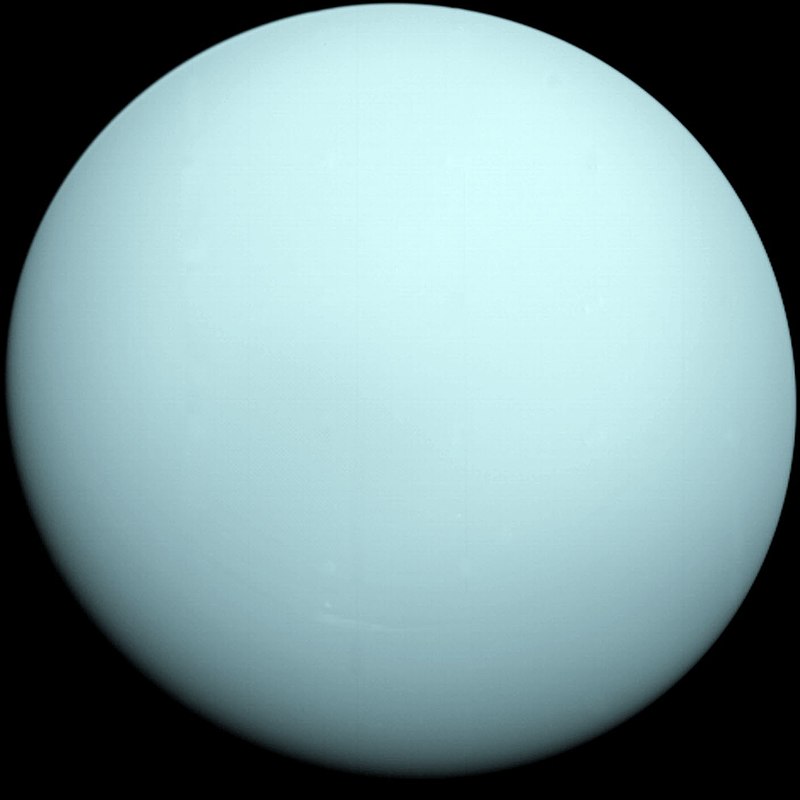
Photographed as a featureless disc by Voyager 2 in 1986
Uranus (from the Latin name Ūranus for the Greek god Οὐρανός) is the seventh planet from the Sun. It has the third-largest planetary radius and fourth-largest planetary mass in the Solar System. Uranus is similar in composition to Neptune, and both have bulk chemical compositions which differ from that of the larger gas giants Jupiter and Saturn. For this reason, scientists often classify Uranus and Neptune as "ice giants" to distinguish them from the gas giants. Uranus' atmosphere is similar to Jupiter's and Saturn's in its primary composition of hydrogen and helium, but it contains more "ices" such as water, ammonia, and methane, along with traces of other hydrocarbons. It has the coldest planetary atmosphere in the Solar System, with a minimum temperature of 49 K (−224 °C; −371 °F), and has a complex, layered cloud structure with water thought to make up the lowest clouds and methane the uppermost layer of clouds. The interior of Uranus is mainly composed of ices and rock.
Like the other giant planets, Uranus has a ring system, a magnetosphere, and numerous moons. The Uranian system has a unique configuration because its axis of rotation is tilted sideways, nearly into the plane of its solar orbit. Its north and south poles, therefore, lie where most other planets have their equators. In 1986, images from Voyager 2 showed Uranus as an almost featureless planet in visible light, without the cloud bands or storms associated with the other giant planets. Observations from Earth have shown seasonal change and increased weather activity as Uranus approached its equinox in 2007. Wind speeds can reach 250 metres per second (900 km/h; 560 mph).

Simulated Earth view of Uranus from 1986 to 2030, from southern summer solstice in 1986 to equinox in 2007 and northern summer solstice in 2028.
At ultraviolet and visible wavelengths, Uranus' atmosphere is bland in comparison to the other giant planets, even to Neptune, which it otherwise closely resembles. When Voyager 2 flew by Uranus in 1986, it observed a total of ten cloud features across the entire planet. One proposed explanation for this dearth of features is that Uranus' internal heat appears markedly lower than that of the other giant planets. The lowest temperature recorded in Uranus' tropopause is 49 K (−224 °C; −371 °F), making Uranus the coldest planet in the Solar System.
Like the classical planets, Uranus is visible to the naked eye, but it was never recognised as a planet by ancient observers because of its dimness and slow orbit. Sir William Herschel first observed Uranus on 13 March 1781, leading to its discovery as a planet, expanding the known boundaries of the Solar System for the first time in history and making Uranus the first planet classified as such with the aid of a telescope.
The rotational period of the interior of Uranus is 17 hours, 14 minutes. As on all the giant planets, its upper atmosphere experiences strong winds in the direction of rotation. At some latitudes, such as about 60 degrees south, visible features of the atmosphere move much faster, making a full rotation in as little as 14 hours.

Aurorae on Uranus taken by the Space Telescope Imaging Spectrograph (STIS) installed on Hubble.
Uranus has 27 known natural satellites. The names of these satellites are chosen from characters in the works of Shakespeare and Alexander Pope. The five main satellites are Miranda, Ariel, Umbriel, Titania, and Oberon.] The Uranian satellite system is the least massive among those of the giant planets; the combined mass of the five major satellites would be less than half that of Triton (largest moon of Neptune) alone. The largest of Uranus' satellites, Titania, has a radius of only 788.9 km (490.2 mi), or less than half that of the Moon, but slightly more than Rhea, the second-largest satellite of Saturn, making Titania the eighth-largest moon in the Solar System. Uranus' satellites have relatively low albedos; ranging from 0.20 for Umbriel to 0.35 for Ariel (in green light). They are ice–rock conglomerates composed of roughly 50% ice and 50% rock. The ice may include ammonia and carbon dioxide.

Montage of Uranus' five largest satellites. From left to right in order of increasing distance from Uranus are Miranda, Ariel, Umbriel, Titania and Oberon. Images are presented to show correct relative sizes and brightness. Coverage is incomplete for Miranda and Ariel; gray circles depict missing areas (original caption from NASA though revised as image has been rotated).

Uranus' southern hemisphere in approximate natural colour (left) and in shorter wavelengths (right), showing its faint cloud bands and atmospheric "hood" as seen by Voyager 2
Uranus' mass is roughly 14.5 times that of Earth, making it the least massive of the giant planets. Its diameter is slightly larger than Neptune's at roughly four times that of Earth. A resulting density of 1.27 g/cm3 makes Uranus the second least dense planet, after Saturn. This value indicates that it is made primarily of various ices, such as water, ammonia, and methane. The total mass of ice in Uranus' interior is not precisely known, because different figures emerge depending on the model chosen; it must be between 9.3 and 13.5 Earth masses Hydrogen and helium constitute only a small part of the total, with between 0.5 and 1.5 Earth masses. The remainder of the non-ice mass (0.5 to 3.7 Earth masses) is accounted for by rocky material.
Uranus is the only planet whose name is derived directly from a figure from Greek mythology, from the Latinised version of the Greek god of the sky Ouranos.